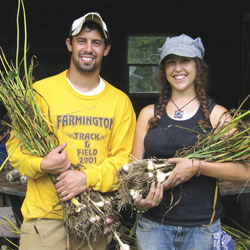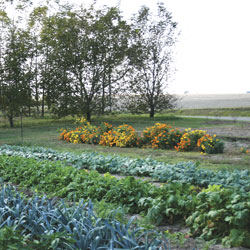
Upon hearing the words, “sustainable food movement,” one might assume it’s just some new-age agricultural fad. But the sustainable food movement is not merely a phase or a fad—it appears to be here to stay as our society becomes more conscious of taking care of the planet that supports our very lives. As the movement grows exponentially in the United States, it gives rise to many new business outlets and ventures.
Food & Sustainability
Gina Edwards, of the online magazine …and she cooks too!, said sustainability is a way of life, and as such, is not easily defined. She pointed us toward Sustainable Table, a nonprofit organization created in 2003 to help consumers understand the problems with our food supply and offer viable solutions and alternatives. They describe sustainability as it relates to food and agriculture: “When a process is sustainable, it can be maintained indefinitely. This is because sustainable farmers do not take more resources from the earth to produce food than they give back.”
Just like the sustainable energy movement that’s getting hotter by the day, the sustainable food movement encourages everyone—land owners, farmers, workers and even eaters—to consider where their food comes from and how it’s grown, processed, shipped and sold. Asking questions is a good place to start: Where does my food come from? Is it grown in foreign countries? Is it harvested by workers who are mistreated and make poor wages? How far does it have to travel? How much fossil fuel is used to get food to my table? Such questions help us understand that a lot more goes into getting food than the convenient trip we make to the grocery store on our way home from work. Sustainable Table and its creator, Diane Hatz, work tirelessly to help consumers understand the details and importance of eating sustainably.
 The Earth Is an Ally
The Earth Is an Ally
The sustainable food movement isn’t just for farmers, but for consumers as well. As eaters—and we all fall into that category—we have a responsibility to look into how we are affecting the environment around us, be it in the way we get to and from work or how we obtain the food we eat. By simply visiting www.sustainabletable.org, you can learn a lot about the movement and the differences between factory farms, where most of our food comes from, and sustainable farms.
Sustainable farms do not pollute the air and water around them as many factory farms do. The relationship between sustainable farmers and the earth, which provides their sustenance, is one of respect. Sustainable Table explains, “Because sustainable farmers see nature as an ally rather than an obstacle, they are able to produce more wholesome food while using less fossil fuels…and without using any synthetic pesticides, artificial hormones or antibiotics.”
Better For Everyone
Food grown on and sold by sustainable farms is often better for the body than what can be purchased from grocery stores. Because sustainable farmers generally sell their products to those who live around them, it travels a much shorter distance than food from factory farms. This allows sustainable farmers to harvest much closer to the proper time, allowing it to ripen, both in terms of flavor and nutrient content. Anecdotally, most people who eat food grown on sustainable farms say it tastes much better than what they can buy at the store. When farmers deal with consumers directly, they often plant according to what their clients want. Other times, farmers plant their crops and allow customers to choose what they would like to buy each week or month.
Not only is the food grown on sustainable farms good for the environment and better for your body, it’s better for your community as well. “By eating sustainably,” Sustainable Table says, “you’re supporting a true American tradition that’s part of our cultural heritage—the small, independent family farmer.” With current economic trends, more focus is being given to keeping money in the community by supporting local businesses.
Fortunately, central Illinois has several local farms which cater to consumers in the Peoria area. While they may not all sell out of their farms, most of them travel short distances to local farmers’ markets each Saturday in the summer.
Another benefit which sustainable farms afford their communities is offering fair wages to workers. We’ve all heard the stories about how poorly many factory farm laborers are paid and treated. That is not the case with sustainable farms. The sustainable food movement includes paying workers fair wages and treating them with the respect they deserve as people. When someone is employed in the community in which they live and is paid at a decent rate, that money is more likely to be spent within the community as well.
When we view the earth as an ally and something on which humanity will forever rely, we can reap the benefits of tastier, more nutritious food. By eating sustainably and supporting local farms, we not only help ourselves, but the environment around us and the community in which we live. Across the country, the sustainable food movement has taken off, and the Peoria area definitely benefits from being in the heartland, at the center of it all. iBi

